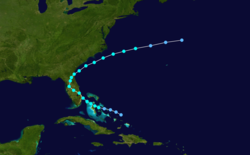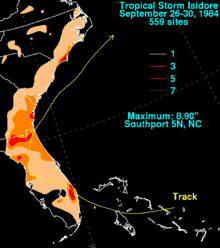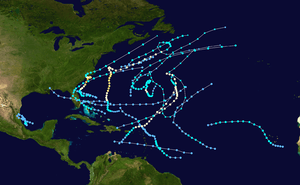Tropical Storm Isidore (1984)
Tropical Storm Isidore was the 15th tropical cyclone and 9th named storm of the 1984 Atlantic hurricane season. Isidore formed as a tropical depression on September 25, while situated off the southeastern Bahamas. The depression headed west, and was upgraded to a tropical storm in the central Bahamas the next day. It made landfall near Jupiter, Florida, and retaining tropical storm strength, Isidore curved to the northeast, emerging over water near Jacksonville, Florida. Isidore continued northeast until it was absorbed by a frontal system on October 1. Though damage was generally light, the storm affected several regions from the Bahamas to the U.S. East Coast. One death was reported in Florida, and total damage is estimated at $1 million (1984 USD).
| Tropical storm (SSHWS/NWS) | |
 Tropical Storm Isidore near peak intensity over the Bahamas on September 26 | |
| Formed | September 25, 1984 |
|---|---|
| Dissipated | October 1, 1984 |
| Highest winds | 1-minute sustained: 60 mph (95 km/h) |
| Lowest pressure | 999 mbar (hPa); 29.5 inHg |
| Fatalities | 1 indirect |
| Damage | $1 million (1984 USD) |
| Areas affected | The Bahamas, Florida, Southeast United States |
| Part of the 1984 Atlantic hurricane season | |
Meteorological history

The storm system that would become Isidore originated in a nearly stationary frontal boundary situated near the Bahamas. On September 24, a ship reported winds of about 30 mph (48 km/h) in association with the disturbance. However, satellite imagery indicated that convection was just beginning to organize. Satellite imagery and Air Force reconnaissance reports documented the formation of a tropical depression early on September 25; a special statement was later issued by the National Hurricane Center (NHC) confirming the existence of the depression, and tropical cyclone advisories were initiated at 12 pm EDT.[1] The depression moved west-northwest while tracking through the Bahamas. As it did so, it moved across Cat Island and passed near several others.[1] The cyclone attained tropical storm status on September 26, receiving the name "Isidore".[2]
While located near the northern tip of Andros Island, Isidore reached its peak intensity. The barometric pressure fell to 999 mb, with sustained winds of 60 mph (95 km/h). The storm continued moving northwest, though it failed to strengthen significantly over the Florida Current. The cyclone made landfall near Jupiter, Florida with sustained winds of about 50 mph (80 km/h) and subsequently moved inland. Previously, a large high pressure area over the eastern United States had prevented the cyclone from moving northward. The high moved away, allowing for Isidore to curve to the northeast, emerging over water near Jacksonville, Florida. The storm continued towards the northeast, passing about 80 mi (130 km) off of the Carolina coast. Isidore downgraded to a tropical depression on October 1, and was absorbed in a frontal zone later that day. Isidore was one of many storms during the 1984 season that formed in relatively cool baroclinic environments.[2]
Preparations

Due to its mild nature, Isidore was described as a "safety test".[3] Gale warnings were issued from as far south as Key West, Florida, to as far north as Virginia, including parts of Georgia, South Carolina, and North Carolina.[4] A private meteorological service stated that Isidore was to intensify to hurricane status, leading to some confusion regarding preparations.[5] Along the Treasure Coast of Florida, citrus farmers burned seedlings potentially infected with canker to prevent heavy rains from spreading the disease.[6] Red Cross volunteers readied a shelter with supplies such as cots and sheets, though it remained unused. In Martin County, hundreds of firefighters were on standby.[7] In Miami, rain from the storm led to the cancellation of horse races at the Calder Race Course. State parks in Monroe County were temporarily closed.[8]
In Indian River, Martin, and St. Lucie counties, students were sent home early, and after-school actives were canceled. The South Beach Jetty Park in Fort Pierce was closed.[7] In southern portions of the state, residents prepared their boats for the storm, and 50 F-4 Phantom fighter jets were evacuated from the Homestead Air Force Base and moved to bases in South Carolina.[9] Lumber yards, groceries stores, and hardware stores reported unusually high demand for emergency supplies, though certain smaller businesses closed early. Gasoline stations in the region "were doing bumper-to-bumper business".[10] Farther to the south, in the Florida Keys, an emergency operations center was opened in response to the storm.[11]
Impact
In Nassau, Bahamas, Isidore produced flooding rains and gales.[12] There, the storm forced the closure of schools and banks.[13] Heavy precipitation fell throughout the island chain, but no serious damage was reported.[14]
Winds from Isidore gusted to 73 mph (117 km/h) in the St. Augustine, Florida area. Elsewhere, 65 mph (105 km/h) winds were recorded. At Mayport, winds were sustained at 43 mph (69 km/h). In northern portions of the state, peak rainfall totals ranged from 5 to 7 in (130 to 180 mm), much of which was associated with an intense convective band to the north and east of the cyclone's center.[15] One tornado, ranked F1 on the Fujita scale, touched down near Savannah, Georgia.[16] Power outages were mostly minor and scattered.[8] Tides generally ran under 3 ft (0.91 m) above normal; combined with high winds, the tides contributed to severe and widespread beach erosion along the eastern coast of central Florida, threatening structures at times.[8] A large, $500,000 beach restoration fill was washed away. Additionally, segments of State Road A1A were damaged. On Hutchinson Island, many eggs and nests of Caretta caretta and Chelonia mydas, respectively, were destroyed. One man was electrocuted as a result of the storm near Orlando.[17] Another man was injured while attempting to land his plane in high winds.[18] Throughout the state, overall damage was generally insignificant.[17]
The storm also dropped heavy precipitation along the coasts of Georgia, South Carolina, and North Carolina, with sporadic showers in parts of Virginia.[19] Offshore, swells of 12 to 15 ft (3.7 to 4.6 m) extensively damaged a wooden ship, the Phoenix. The vessel "barely escaped destruction", though a crew member suffered a cracked rib.[20] Across its path, Isidore was estimated to have inflicted $1 million in damage.[5]
See also
- List of Florida hurricanes
- List of Atlantic hurricanes
References
- Harold Gerrish (October 29, 1984). "Tropical Storm Isidore Preliminary Report". National Hurricane Center. Retrieved 2009-06-04.
- Harold Gerrish (October 29, 1984). "Tropical Storm Isidore Preliminary Report Page 2". National Hurricane Center. Retrieved 2009-06-04.
- Staff Writer (September 29, 1984). "Mild Isidore Called a Safety Test". Miami Herald. Retrieved 2009-06-05.
- Harold Gerrish (October 29, 1984). "Tropical Storm Isidore Preliminary Report Page 9". National Hurricane Center. Retrieved 2009-06-04.
- Miles Lawrence and Gilbert Clark. "Atlantic Hurricane Season of 1984" (PDF). National Hurricane Center. Retrieved 2009-06-05.
- Staff Writer (September 27, 1984). "Treasure Coast Braces for Storm". Miami Herald. Retrieved 2009-06-05.
- Staff Writer (September 28, 1984). "Isidore Teases the Treasure Coast". Miami Herald. Retrieved 2009-06-05.
- Staff Writer (September 28, 1984). "Tropical storm Isidore brushes Florida coast". Galveston Daily News.
- Arnold Markowitz and Stephen Doig (September 27, 1984). "Isidore hits coast with rain, wind". Miami Herald.
- Yolanda Ulrich (September 27, 1984). "South Floridians stock up for Isidore's arrival". Miami Herald.
- Patty Shillington (September 27, 1984). "Island residents told to prepare for possible storm". Miami Herald.
- Staff Writer (September 27, 1984). "Storm Isidore Soaks Nassau, Heads Towards Florida's Coast". The Dallas Morning News. Retrieved 2009-06-05.
- Staff Writer (September 27, 1984). "Tropical Storm Pauses After Flooding Nassau". The Dallas Morning News. Retrieved 2009-06-05.
- Staff Writer (September 27, 1984). "New Storm Strengthens, May Head for Miami". Lexington Herald-Leader. Retrieved 2009-06-05.
- Harold Gerrish (October 29, 1984). "Tropical Storm Isidore Preliminary Report Page 3". National Hurricane Center. Retrieved 2009-06-04.
- "Event Record Details: Tornado". National Climatic Data Center. Retrieved 2009-06-06.
- Harold Gerrish (October 29, 1984). "Tropical Storm Isidore Preliminary Report Page 4". National Hurricane Center. Retrieved 2009-06-04.
- Staff Writer (September 19, 1984). "Isidore heads towards coast of Georgia". Gainesville Sun. Retrieved 2009-06-05.
- David Roth. "Tropical Storm Isidore - September 26–30, 1984". Hydrometeorological Prediction Center. Retrieved 2009-06-05.
- Staff Writer (October 5, 1984). "Tropical Storm Isidore left 'Phoenix' at sea's mercy". The Evening Independent.
